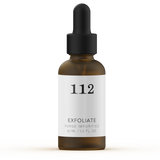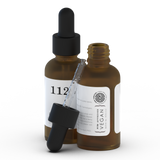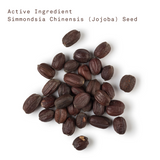All Ingredients: Simmondsia Chinensis (Jojoba) Seed Oil
- Incidecoder Rating: Goodie
- EWG Rating: 1 (Best)
- PETA Rating: Cruelty Free & Vegan
- Origin: Cold pressed from jojoba seeds, sustainably grown in Israel.
Honest Research
Jojoba is a drought resistant evergreen shrub native to South-western North America. It's known and grown for jojoba oil, the golden yellow liquid coming from the seeds (about 50% of the weight of the seeds will be oil).
At first glance, it seems like your average emollient plant oil: it looks like an oil and it's nourishing and moisturizing to the skin but if we dig a bit deeper, it turns out that jojoba oil is really special and unique: technically - or rather chemically - it's not an oil but a wax ester (and calling it an oil is kind of sloppy).
So what the heck is a wax ester and why is that important anyway? Well, to understand what a wax ester is, you first have to know that oils are chemically triglycerides: one glycerin + three fatty acids attached to it. The fatty acids attached to the glycerin vary and thus we have many kinds of oils, but they are all triglycerides. Mother Nature created triglycerides to be easily hydrolyzed (be broken down to a glycerin + 3 fatty acid molecules) and oxidized (the fatty acid is broken down into small parts) - this happens basically when we eat fats or oils and our body generates energy from it.
Mother Nature also created wax esters but for a totally different purpose. Chemically, a wax ester is a fatty acid + a fatty alcohol, one long molecule. Wax esters are on the outer surface of several plant leaves to give them environmental protection. 25-30% of human sebum is also wax esters to give us people environmental protection.
So being a wax ester results in a couple of unique properties: First, jojoba oil is extremely stable. Like crazy stable. Even if you heat it to 370 C (698 F) for 96 hours, it does not budge. (Many plant oils tend to go off pretty quickly). If you have some pure jojoba oil at home, you should be fine using it for years.
Second, jojoba oil is the most similar to human sebum (both being wax esters), and the two are completely miscible. Acne.org has this not fully proven theory that thanks to this, jojoba might be able to "trick" the skin into thinking it has already produced enough sebum, so it might have "skin balancing" properties for oily skin.
Third, jojoba oil moisturizes the skin through a unique dual action: on the one hand, it mixes with sebum and forms a thin, non-greasy, semi-occlusive layer; on the other hand, it absorbs into the skin through pores and hair follicles then diffuses into the intercellular spaces of the outer layer of the skin to make it soft and supple.
On balance, the point is this: in contrast to real plant oils, wax esters were designed by Mother Nature to stay on the surface and form a protective, moisturizing barrier and jojoba oil being a wax ester is uniquely excellent at doing that.
Some proof
- Tzu-Kai Lin, Lily Zhong, and Juan Luis Santiago, Int J Mol Sci. 2018 Jan; 19(1): 70, Anti-Inflammatory and Skin Barrier Repair Effects of Topical Application of Some Plant Oils.
- Global Journal of Agricultural Food Safety Science, Vol.2 (3): pp. 270 283 (2015), Chemical studies on grown jojoba oils under Egyptian conditions.
When to use
At night, before sleeping.
How to apply
Apply 2-3 drops and wait for 3-4 minutes for your skin to absorb. Repeat this until you find excess on your skin. Use a damp cloth to remove the excess.
Frequency of use
If your concern is severe, use every night. Otherwise, use every alternate night.
Safe to use during
- Menstrual pain
- Pregnancy or breastfeeding
- Menopause
Use with other products
Mix 1 drop of every product on your palm, rub your palms, and apply the mixture. Wait for 3-4 minutes for your skin to absorb. Repeat this until you find excess on your skin. Use a damp cloth to remove the excess.
Best practices
- Keep away from children
- Patch test before use
- For external use only
Consult your doctor
For frequency of use, if you are being treated for
- Dermatitis or eczema
- Third-degree burns
- Skin cancer
Afterlife
Re-use the bottle, or empty the glass bottle and place in the recycling bin.










